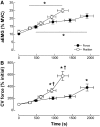Load type influences motor unit recruitment in biceps brachii during a sustained contraction
- PMID: 19625539
- PMCID: PMC2746780
- DOI: 10.1152/jn.00382.2009
Load type influences motor unit recruitment in biceps brachii during a sustained contraction
Abstract
Twenty subjects participated in four experiments designed to compare time to task failure and motor-unit recruitment threshold during contractions sustained at 15% of maximum as the elbow flexor muscles either supported an inertial load (position task) or exerted an equivalent constant torque against a rigid restraint (force task). Subcutaneous branched bipolar electrodes were used to record single motor unit activity from the biceps brachii muscle during ramp contractions performed before and at 50 and 90% of the time to failure for the position task during both fatiguing contractions. The time to task failure was briefer for the position task than for the force task (P=0.0002). Thirty and 29 motor units were isolated during the force and position tasks, respectively. The recruitment threshold declined by 48 and 30% (P=0.0001) during the position task for motor units with an initial recruitment threshold below and above the target force, respectively, whereas no significant change in recruitment threshold was observed during the force task. Changes in recruitment threshold were associated with a decrease in the mean discharge rate (-16%), an increase in discharge rate variability (+40%), and a prolongation of the first two interspike intervals (+29 and +13%). These data indicate that there were faster changes in motor unit recruitment and rate coding during the position task than the force task despite a similar net muscle torque during both tasks. Moreover, the results suggest that the differential synaptic input observed during the position task influences most of the motor unit pool.
Figures







Similar articles
-
Motor unit activity in biceps brachii of left-handed humans during sustained contractions with two load types.J Neurophysiol. 2016 Sep 1;116(3):1358-65. doi: 10.1152/jn.00147.2016. Epub 2016 Jun 22. J Neurophysiol. 2016. PMID: 27334949 Free PMC article.
-
Motor-unit activity differs with load type during a fatiguing contraction.J Neurophysiol. 2005 Mar;93(3):1381-92. doi: 10.1152/jn.00837.2004. Epub 2004 Oct 13. J Neurophysiol. 2005. PMID: 15483059
-
Eccentric muscle damage has variable effects on motor unit recruitment thresholds and discharge patterns in elbow flexor muscles.J Neurophysiol. 2009 Jul;102(1):413-23. doi: 10.1152/jn.91285.2008. Epub 2009 May 6. J Neurophysiol. 2009. PMID: 19420118
-
Discharge of biceps brachii motor units is modulated by load compliance and forearm posture.Exp Brain Res. 2010 Apr;202(1):111-20. doi: 10.1007/s00221-009-2116-7. Epub 2009 Dec 11. Exp Brain Res. 2010. PMID: 20012532 Clinical Trial.
-
Task failure during fatiguing contractions performed by humans.J Appl Physiol (1985). 2005 Aug;99(2):389-96. doi: 10.1152/japplphysiol.00207.2005. J Appl Physiol (1985). 2005. PMID: 16020434 Review.
Cited by
-
Endurance time is joint-specific: a modelling and meta-analysis investigation.Ergonomics. 2010 Jan;53(1):109-29. doi: 10.1080/00140130903389068. Ergonomics. 2010. PMID: 20069487 Free PMC article.
-
Motor unit activity in biceps brachii of left-handed humans during sustained contractions with two load types.J Neurophysiol. 2016 Sep 1;116(3):1358-65. doi: 10.1152/jn.00147.2016. Epub 2016 Jun 22. J Neurophysiol. 2016. PMID: 27334949 Free PMC article.
-
Task- and time-dependent modulation of Ia presynaptic inhibition during fatiguing contractions performed by humans.J Neurophysiol. 2011 Jul;106(1):265-73. doi: 10.1152/jn.00954.2010. Epub 2011 May 4. J Neurophysiol. 2011. PMID: 21543747 Free PMC article. Clinical Trial.
-
Neuromuscular fatigability is not affected by the contraction pattern of exercises with a similar mean torque.Eur J Appl Physiol. 2025 Apr;125(4):1115-1127. doi: 10.1007/s00421-024-05660-7. Epub 2024 Nov 25. Eur J Appl Physiol. 2025. PMID: 39586887
-
Regional differences of [(18)F]-FDG uptake within the brain during fatiguing muscle contractions.Brain Behav. 2015 Apr;5(4):e00319. doi: 10.1002/brb3.319. Epub 2015 Feb 17. Brain Behav. 2015. PMID: 25798334 Free PMC article.
References
-
- Akazawa K, Milner TE, Stein RB. Modulation of reflex EMG and stiffness in response to stretch of human finger muscle. J Neurophysiol 49: 16–27, 1983. - PubMed
-
- Baudry S, Jordan K, Enoka RM. Presynaptic inhibition of Ia afferents in humans changes during fatiguing contractions. Neuroscience Annual Meeting 2008a.
-
- Baudry S, Jordan K, Enoka RM. Heteronymous reflex responses in a hand muscle when maintaining constant finger force or position at different contraction intensities. Clin Neurophysiol 120: 210–217, 2009. - PubMed
-
- Baudry S, Rudroff T, Pierpoint LA, Enoka RM. Influence of load type on motor unit recruitment threshold during a sustained submaximal contraction. Presented at the Symposium Mechanisms of Plasticity and Disease in Motoneurons, Seattle, WA, June 26–29, 2008b.
Publication types
MeSH terms
Grants and funding
LinkOut - more resources
Full Text Sources

